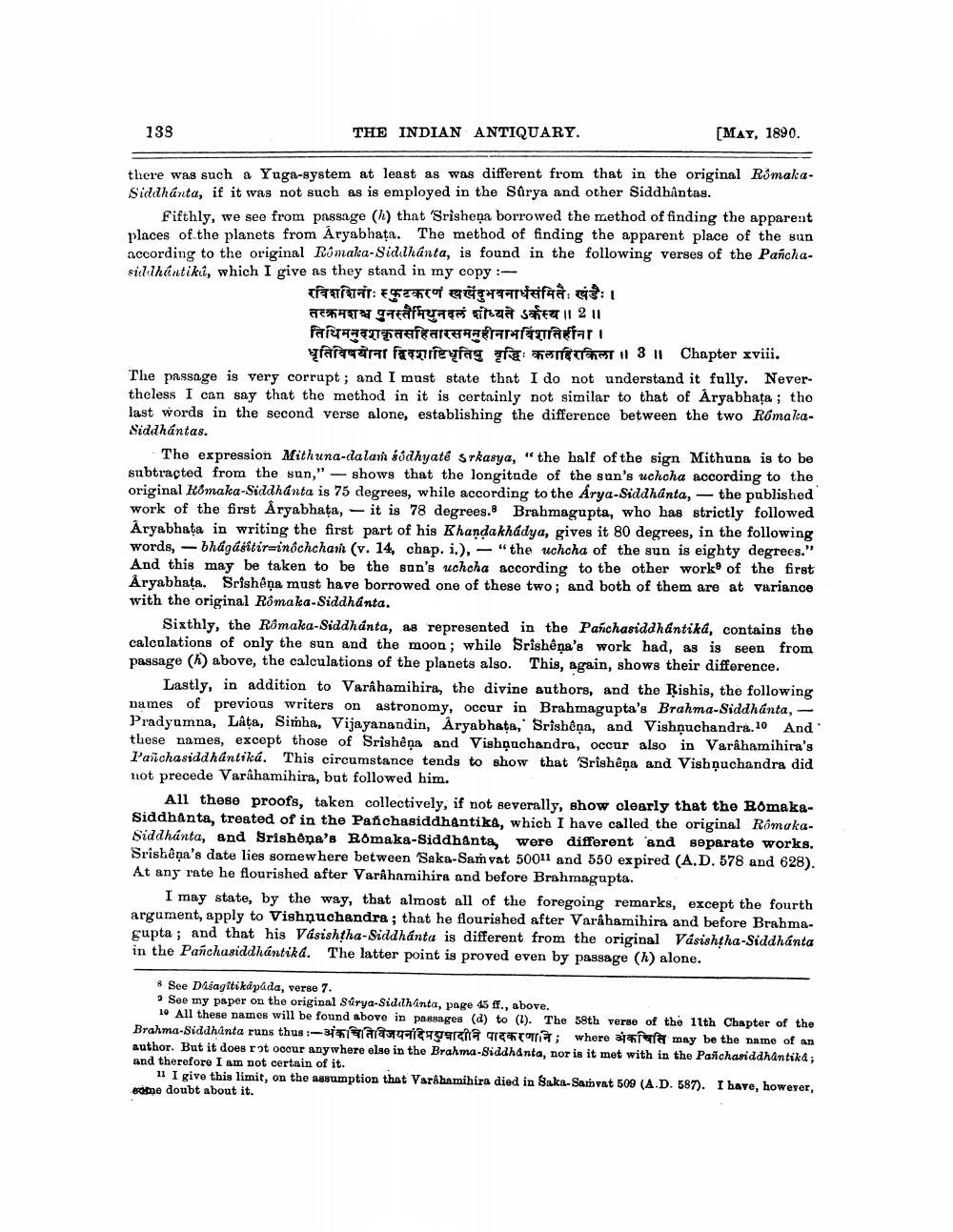________________
133
THE INDIAN ANTIQUARY.
[MAY, 1890.
there was such a Yuga-system at least as was different from that in the original RimakaSiddhánta, if it was not such as is employed in the Sûrya and other Siddhantas.
Fifthly, we see from passage (h) that 'Srishena borrowed the method of finding the apparent places of the planets from Aryabhata. The method of finding the apparent place of the sun according to the original Rómaka-Siddhanta, is found in the following verses of the Panchasic théutiki, which I give as they stand in my copy :
रविशशिनाः स्फुटकरणं खच्दुभवनार्धसंमितेः खंडैः। तत्क्रमशश्च पुनस्तर्मिधुनदलं शोध्यते ऽर्कस्य ।।2।। तिथिमनुदशकृतसहितारसमनुहीनाभविंशतिहीना ।
yrarårar faireyfag representert 11 3 11 Chapter xviii. The passage is very corrupt; and I must state that I do not understand it fully. Nevertheless I can say that the method in it is certainly not similar to that of Aryabhata ; tho last words in the second verse alone, establishing the difference between the two RómakaSiddhantas.
The expression Mithuna-dalar sodhyaté stkasya, "the half of the sign Mithuna is to be subtracted from the sun," - shows that the longitude of the sun's uchcha according to the original Romaka-Siddhanta is 75 degrees, while according to the Arya-Siddhanta, - the published work of the first Åryabhata, - it is 78 degrees. Brahmagupta, who has strictly followed Aryabhata in writing the first part of his Khandakhádya, gives it 80 degrees, in the following words, - bhagasitir=inôchchan (v. 14, chap. i.), - "the uchcha of the sun is eighty degrees." And this may be taken to be the son's uchcha according to the other work of the first Åryabhata. Srishêņa must have borrowed one of these two; and both of them are at variance with the original Rómaka-Siddhanta.
Sixthly, the Rômaka-Siddhanta, as represented in the Panchasiddhantiká, contains the calculations of only the sun and the moon; while Srishêna's work had, as is seen from passage (h) above, the calculations of the planets also. This, again, shows their difference.
Lastly, in addition to Varahamihira, the divine authors, and the Rishis, the following names of previous writers on astronomy, occur in Brahmagupta's Brahma-Siddhanta, Pradyumna, Låta, Simha, Vijayanandin, Aryabhata, Srishĉņa, and Vishộuchandra.10 And these names, except those of Srishêņa and Vishộuchandra, occur also in Varahamihira's Panchasiddhantiká. This circumstance tends to show that Srishêņa and Vishnuchandra did not precede Varahamihira, but followed him.
All these proofs, taken collectively, if not severally, show clearly that the RomakaSiddhanta, treated of in the Panchasiddhantika, which I have called the original RômakaSiddhanta, and Srishóna's Romaka-Siddhanta, were different and separate works. Srishêņa's date lies somewhere between Saka-Samvat 50011 and 550 expired (A.D. 578 and 628). At any rate he flourished after Varahamihira and before Brahmagupta.
I may state, by the way, that almost all of the foregoing remarks, except the fourth argument, apply to Vishnuchandra ; that he flourished after Varahamihira and before Brahmagupta ; and that his Väsishtha-Siddhanta is different from the original Vásishtha-Siddhanta in the Panchasiddhantika. The latter point is proved even by passage (h) alone.
* See Disagitikapáda, verse 7. . See my paper on the original Sürya-Siddhanta, page 45 ff., above.
10 All these names will be found above in passages (d) to (1). The 58th verse of the 11th Chapter of the Brahma-siddhanta runs thus:-अंकचितिविजयनांदप्राचादीन पादकरणानि; where अंकचिति may be the name of an author. But it does rot oocur anywhere else in the Brahma-Siddhanta, nor is it met with in the Panchasiddhantika; and therefore I am not certain of it.
11 I give this limit, on the assumption that Vardhamihira died in Baka-Samvat 509 (A.D. 587). I have, however, come doubt about it.




